Aylesbury, Buckinghamshire
Up to 1834
The 1725 edition of An Account of Several Workhouses... mentions the existence of parish workhouses in Ailesbury, Asheton Clenton and Wingrave. A parliamentary report of 1777 recorded parish workhouses in operation in Aylesbury with accommodation for up to 90 inmates, and at Wingrove for 20 inmates.
Aylesbury's first parish workhouse was in St Mary's Square, at the north-east corner of, and opening into, the churchyard. According to Gibbs (1885),
In 1758, the workhouse is mentioned in the parish vestry minutes when it was resolved that "under no pretence whatever, should the overseers pay or cause to be paid any sum or sums of money for the relief of persons who refuse to come into the workhouse, and that after Michaelmas no rents will be paid or allowed."
By the 1780s, the operation of the workhouse was being contracted out under the "farming" procedure. Tenders were taken from interested parties who were prepared to undertake the board, clothing and general management of the workhouse at so much per head per week. In 1781, William Foreman agreed to maintain the poor of the parish for the sum of £669 for a period of one year. In 1825, the contract was for 4s.6d. per head per week. If the price of food rose unexpectedly, the contractor might be paid extra to cover this. Specific provision was occasionally also made for children in the workhouse, At one time, twelve catechism books were bought; at another payments for schooling, only for boys, were made at a rate of 2d per boy were week.
The churchyard frontage of the workhouse building was later converted into cottages and the rear occupied by British School buildings.
Overcrowding of the St Mary's Square workhouse led, in 1829, to the erection of a new and larger workhouse. Two acres of land for the new building was donated by Mr Rickford on the Oxford Road on the site of what is now Mount Street and St Mary's School. An idea of workhouse life at this time is given by a list of workhouse rules which dates from 1831.
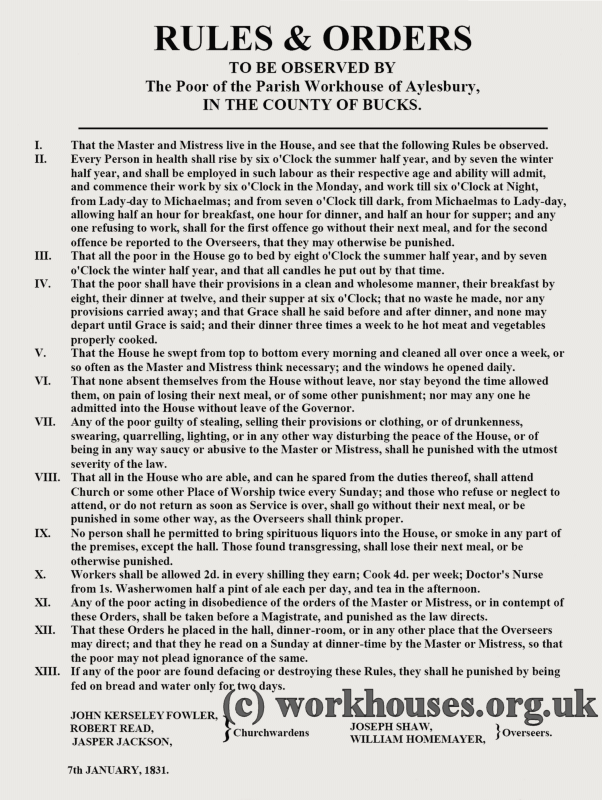
Aylesbury workhouse rules, 1831.
© Peter Higginbotham.
After 1834
Aylesbury Poor Law Union officially came into existence on 6th July 1835. Its operation was overseen by an elected Board of Guardians, 48 in number, representing its 40 constituent parishes as listed below (figures in brackets indicate numbers of Guardians if more than one):
County of Buckingham:
Ashendon-cum-Pollecot, Aston Abbots, Aston Clinton (2), Aston Sandford, Aylesbury with Walton (6), Bierton with Broughton, Buckland, Chearsley, Cholesbury, Creslow, Cublington, Cuddington, Dinton-with-Ford and Upton, Drayton Beauchamp, Fleet Marston, Grendon Underwood, Haddenham (2), Halton, Hardwick, Hartwell, Hawridge, Hulcott, Kingswood, Ludgershall, Oving, Pitchcott, Quainton, Quarrendon, Shipton Lee, Stone, Waddesdon (2), Weedon, Westcott, Weston Turville, Whitchurch, Nether Winchendon, Upper Winchendon, Wingrave with Rowsham, Woodham, Wotton Underwood.
Later Additions: Stoke Mandeville (from 1898).
The population falling within the Union at the 1831 census had been 21,480 with parishes ranging in size from Creslow (population 5) to Aylesbury itself (5,021). The average annual poor-rate expenditure for the period 1832-35 had been £25,221 or £1.3s.6d. per head of the population.
Initially, the new union decided to continue using the recently erected Aylesbury parish workhouse. However, within a few years this proved inadequate and a new union workhouse was built in 1844 on Bierton Road in Aylesbury. It was designed by SO Foden in collaboration with Assistant Poor Law Commissioner HW Parker. Foden was the architect of number of other workhouses including those at Bromley, Cuckfield and Rye. Parker, who in 1845 was to become the scapegoat for the scandal at Andover workhouse, was reputed to object to prison-like appearance of the Commissioners' original workhouse designs. The design for Aylesbury, like their proposed plan for Canterbury workhouse, had two parallel ranges with a short connecting block at the centre which contained the dining-hall and chapel. The layout was unusual in having only walled yards for the able-bodied — the aged and children had areas at front bounded by low fences.
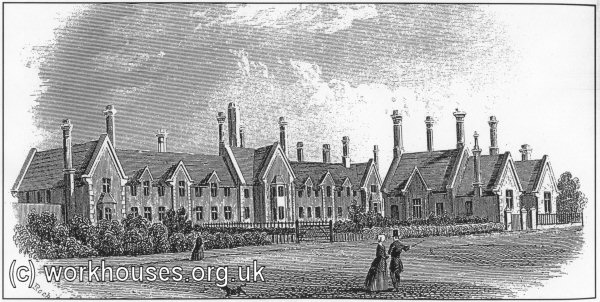
Aylesbury workhouse from the south-west, 1844.
© Peter Higginbotham.
According to Gibbs (1885), the workhouse rooms were
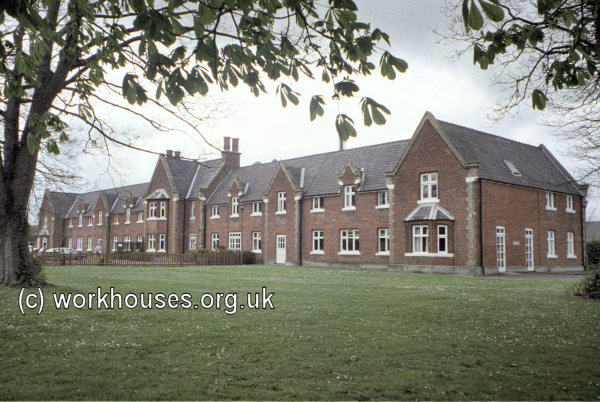
Aylesbury main building from the east, 2000.
© Peter Higginbotham.
There were two small blocks at the entrance to the site. One was a porter's lodge with an adjoining waiting room. The other housed the Guardians' board-room.
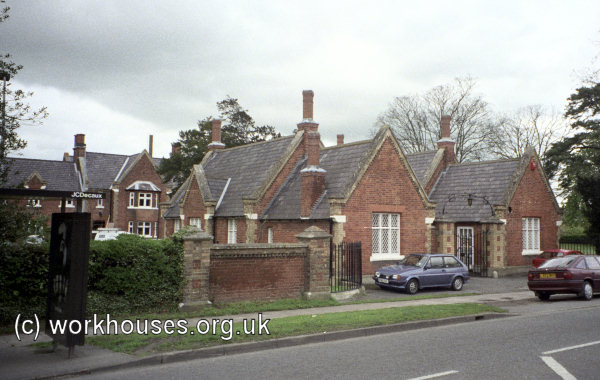
Aylesbury entrance from the south, 2000.
© Peter Higginbotham.
A separate infirmary block was later added at the north of the workhouse where the casual ward, stables and various utility blocks were also located. The site location and layout are shown on the 1925 map below by which time it was officially known as Aylesbury Poor Law Institution.
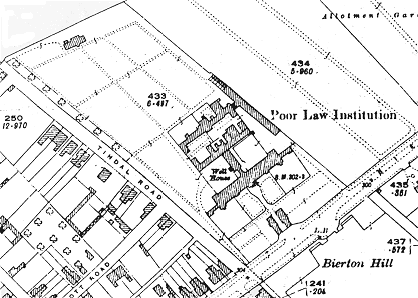
Aylesbury workhouse site, 1925.
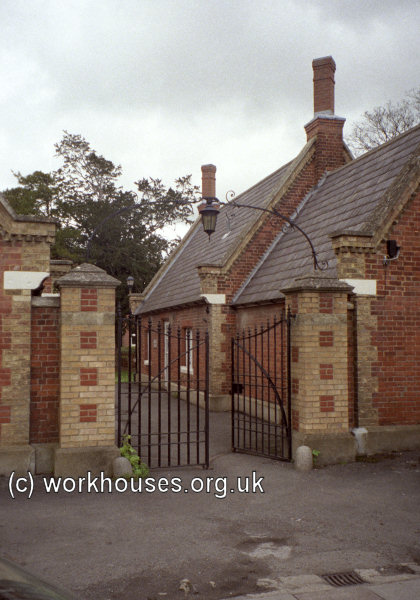
Aylesbury entrance gates from the south, 2000.
© Peter Higginbotham.
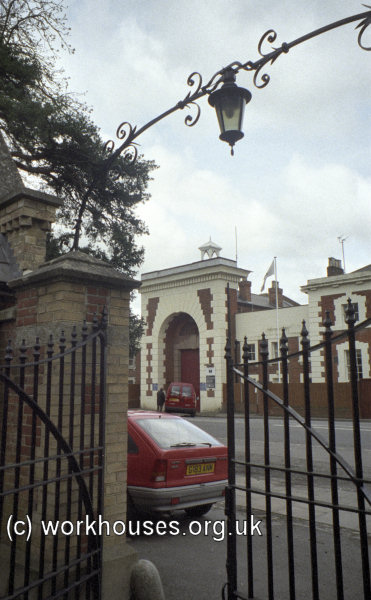
Aylesbury entrance gates from the north-west with view of Aylesbury Prison entrance, 2000.
© Peter Higginbotham.
From 1904, to protect them from disadvantage in later life, the birth certificates for those born in the workhouse gave its address just as 100 Bierton Hill, Aylesbury.
During the Second World War the former workhouse became Tindal Hospital and a large annexe of Emergency Medical Scheme huts was erected on the site to cope with evacuations from London's Middlesex Hospital.
In more recent times, the main block and lodge buildings became home to the Tindal Centre.
The Grendon Underwood Childrens' Home
A detached house known as The Grove was built in Grendon Underwood as a "Gentleman's Hunting Box" in 1874. It was rented out by the Grendon Estate for this purpose until 1911. In September of that year, it was leased to the Aylesbury Board of Guardians at £30 per annum as a home for children to remove them from the influence of the Aylesbury Workhouse.
Initially the house was altered to cater for twenty-one children but when it was opened in March 1912, there were only three bedrooms containing four beds and one with three beds. A fifth room was used by the house Foster Mother, Mrs Marshall. It housed about twenty youngsters for most of its existence. Children from the age of three were sent to the home, boys staying until they were ten and girls leaving when they were a suitable age to go into domestic service at about fourteen or fifteen.
A local committee was appointed to administer the day-to-day running of the home and a doctor appointed as medical officer was paid £5 a year to attend to any sick children. All those of school age attended the village school. Committee members would visit the house on a weekly basis to ensure the children were properly clothed and fed and that they were regularly included in any village activities and celebrations. Local tradesmen tendered, in the same manner as for the Aylesbury Workhouse, to supply goods and services.
At Christmas an extra allowance was made by the Aylesbury Guardians to provide the children with presents and, on several occasions, the committee chairman called on Christmas Day to make sure the day was special. The community as a whole took it upon themselves to make certain that the children had extra food, sweets and small gifts to try and let them lead lives as normal as possible. On one occasion a gramophone was donated. The children were taken out during holiday time on day trips and to the cinema in Aylesbury.
The home ran very smoothly for all of its nine years, apart from one incident when two of the girls of eleven and thirteen were caught trying to set fire to the house. They appeared before the local magistrates at the petty sessions and the elder girl was committed to an Industrial School for two years.
In 1920, the Grendon Estate was auctioned off in 45 lots and The Grove was sold to a private buyer. Notice was given in 1921 to terminate the lease and the Aylesbury Guardians purchased a house in Great Kimble to where the home moved.
The photograph below was taken in front of the home in July, 1913. At the back of the group are the ten members of the committee plus the medical officer. Second from the left is the house foster mother Mrs Marshall. The nineteen children living in the home at that time are at the front.
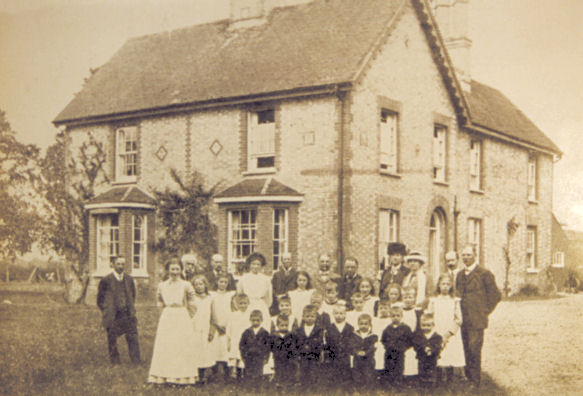
Aylesbury Union's children's home at Grendon Underwood, 1913.
Courtsey of Barry Houghton.
The Grove's replacement at Great Kimble, near Princes Risborough, was a house known as The Mount. It was sometimes referred to, somewhat oddly, as a 'scattered home'.
Staff
Inmates
Bibliography
- Gibbs, Robert (1885) A History of Aylesbury
Links
- None.
Records
Note: many repositories impose a closure period of up to 100 years for records identifying individuals. Before travelling a long distance, always check that the records you want to consult will be available.
- Centre for Buckinghamshire Studies, County Hall, Walton Street, Aylesbury, Bucks HP20 1UU. Relatively few records survive — holdings include: Guardians' minute books (1835-41, 1886-1909, 1911-30).
Acknowledgment
- The section on the Grendon Underwood children's home was researched and written by Barry and Pat Houghton who have very kindly allowed its inclusion here.
Unless otherwise indicated, this page () is copyright Peter Higginbotham. Contents may not be reproduced without permission.


